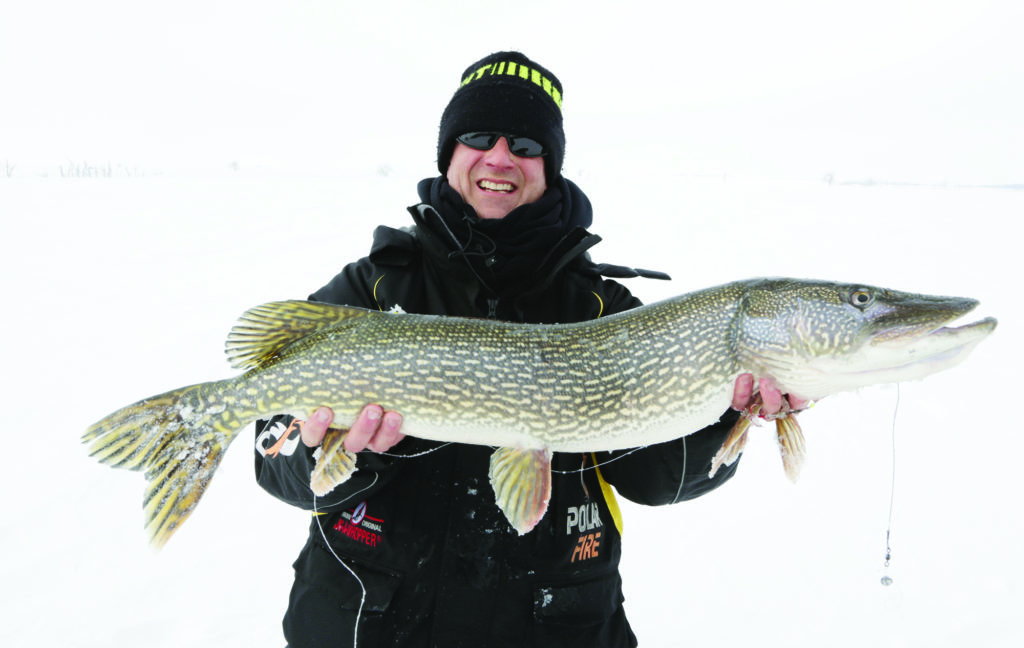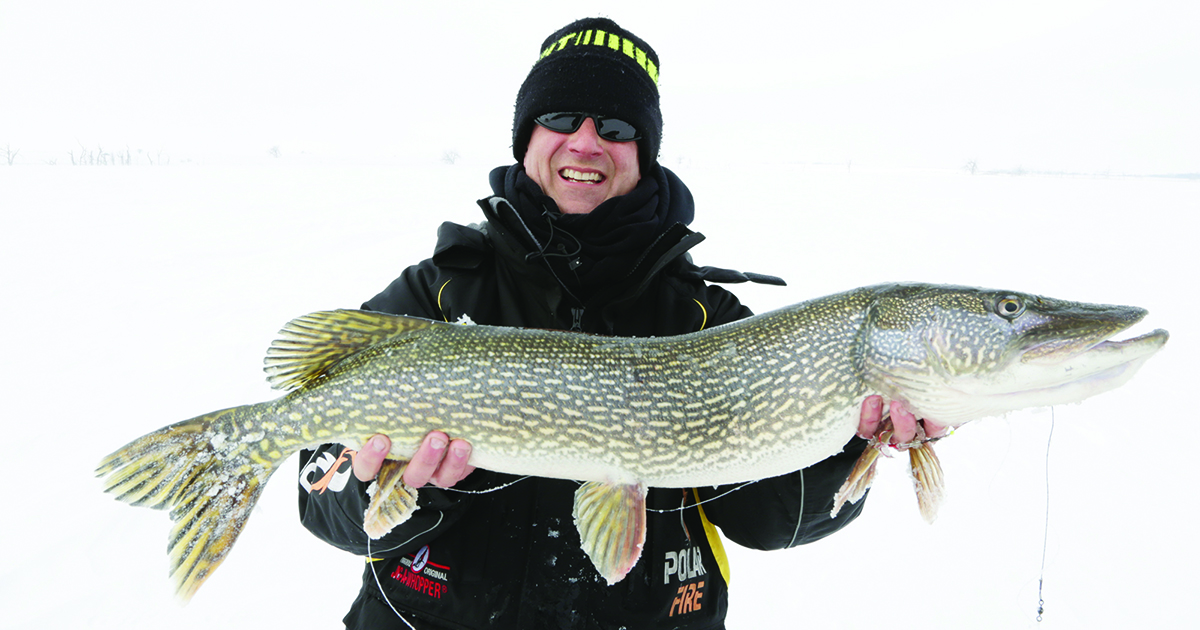Tip-ups have become tightly ingrained within the matrix of ice fishing, and rightfully so.
There’s something captivating about the sudden snap of a flag, the ensuing race to get there, subsequent sight of a rapidly spinning spool, the thrill of a hookset and feel of a heavyweight in hand-to-hand combat — all followed by the intrigue of waiting to see what will ultimately appear at the hole. It’s an experience nearly impossible to match in any other sport!
While this action hasn’t changed much over the years, the scene has evolved. Traditional stick tip-ups are certainly functional, and elementary techniques for using them remain effective. Yet, as modern tip-up designs continue to advance and become increasingly diverse, creative anglers are incorporating and developing an expanding web of innovative strategies and techniques, allowing them to attentively approach each situation with unprecedented levels of efficiency.
This begins with knowledgeable use of electronic mapping, sonar and underwater cameras to identify primary set locations, selectively modifying presentation positions, depths and details, then incorporating the right tip-up designs, features and tactics to best match the conditions. With insulated frames to keep holes from icing, heightened flag wires for increased visibility, interchangeable spools for easy rigging — and perhaps most notably, adjustable tube height settings to allow variable trip setting adjustments, even tilting flag wire bases that permit flag spring tension regulation to further refine trip tension control — there have never been so many elements available to help make your precious time on the ice more productive
Out of all of these innovations, trip tension adjustment is among the most critical, yet ironically overlooked, aspects of modern tip-up engineering. This concept was pioneered on early tip-ups by simply machining a notch on one side of the trip and leaving the other smooth. The notched side offers a heavier setting alternative by requiring slightly greater pressure to trip the flag.

However, that’s just the obvious part. Advanced tension control stems from the capability to raise or lower the height of the tube mechanism. While not complicated, this is a much less understood concept.
HT Enterprises first introduced this feature on their Polar Tip-Ups so that users would have the ability to raise or lower the tube to the desired height, before re-tightening the thumb screw to re-secure the mechanism in the selected position.
By adjusting the tube mechanism height, you either increase or decrease the angle of the flag against the trip. Now, depending on what direction your line flows off of the spool, you can use these modified height settings to increase or decrease trip tension.
How?
Raising the tube to increase the angle, then placing the flag wire on the side where the trip will push up and catch against the flag wire, the trip shaft must consequently press down slightly on the flag wire before traveling up the flag wire to release. The steeper this angle is set, the greater the pressure required to trip the flag — beneficial when fishing heavier presentations, larger, lively minnows, strong currents or contending with gusty winds.
Subsequently, placing the flag wire on the notched side of the trip shaft further expands this spectrum of heavy tension setting options.
Ironically, this increased trip angle can just as easily be used to lessen trip tension. Placing the flag wire on the opposite side where the trip shaft fluidly slips down the flag wire allows the trip to slip nearly effortlessly off of the flag wire when tripped. This method offers considerably less resistance to fussier, lighter-biting fish. And again, using the smooth side of the trip greatly expands the available range of lighter tension setting options.
HT has recently taken this concept a step further, revealing yet another powerful advantage through the development of an adjustable flag spring base — an advancement that allows progressively finer degrees of tension adjustment. Using this feature, you can increase or decrease the angle of the flag wire base. This will increase or decrease the amount of pressure applied by the bent flag spring at the point of contact between the flag wire and the trip.
In other words, instead of pointing straight up, the flag spring can be tilted to modify the pressure applied by the spring against the trip, allowing users to fine-tune tension control with unprecedented precision. The wider or narrower that you set this angle, the greater or less, respectively, the resulting degree of tension, depending how you wish to modify the pressure being exerted by the bent spring.
Once again, don’t forget to place the flag wire on the notched or smooth side of the trip shaft to further modify the trip’s tension. You’ll soon discover a surprisingly wide range of increasingly refined levels of adjustment.
Say, for example, that you’re fishing a heavily weighted dead bait, or trying to set a large, lively sucker over thick, shallow vegetation, or contending with strong currents, gusty winds or a combination of such conditions where an increase in trip tension would be desired. This would best be achieved by raising the tube mechanism to increase the angle of the flag wire — the higher up, the stronger the tension. This would be accomplished by placing the flag wire on the notched side of the trip, positioned so that it must travel up the flag wire to release, then ratcheting the flag base outward to lock it into a wider, outward angle.

Together, depending on the degree that you wish to go, the elevated angle of the flag wire pushing up against the notched side of the trip shaft, and the increased pressure provided by the wider outward angle of the bent flag spring, produce variable, heightened levels of adjustable tension better suited to larger, heavier presentations or conditions when increased tension is beneficial.
Still not enough?
Here’s another trick: Try physically bending the flag wire itself upward — preferably with the bend positioned directly in front of the trip. Depending on the severity of this bend, you’ll add a few additional degrees to the angle between the flag wire and trip. This means that the trip shaft must catch and slide up the flag wire at an even higher pitch, providing yet another heightened range of increased tension adjustment.
As you might expect, modified angles can be equally beneficial on the opposite side of the spectrum. When tough bites happen, or the situation demands a smaller or lighter presentation, try raising the tube mechanism. Then place the flag wire on the smooth side of the trip in such a fashion that the trip shaft easily slides down the flag wire to release. Next, tilt the flag wire base slightly forward in the direction of the trip to decrease the angle of the spring against the trip, thereby reducing the pressure applied by the bent flag spring, as desired. The result is a liquid-smooth, nearly friction-free release.
The advantages of these variations should not be underestimated, because with just a few relatively simple adjustments, settings can be attained that allow you to precisely position baits in a multitude of scenarios. Examples of this adaptability include large dead baits near the bottom, even in current; suspending heavy dead baits or large, lively minnows at specified depths, even in strong winds; incorporate an expanding array of innovative rigs, including a variety blade or spoon baits. Plus, it will allow an equal ability to suspend even the lightest, tiniest presentations with virtually undetectable amounts of tension — all while minimizing false flags.
In that regard, whenever situations where light trips are desired and false flags present serious challenges — such as when facing swirling, gusty winds — try using these light-setting tactics in conjunction with the wind trip bar. This combination allows a full range of refined, light tension adjustments to be used, ensuring neutral- or negative-biting fish will feel little, if any, resistance — and again, all while virtually eliminating false flags.
To properly use a wind trip, simply straddle it (centered) over the trip shaft, then turn the trip 90 degrees into the set position. By doing so, even the strongest swirling winds can’t push the flag wire free. The flag can only release when the spool spins, in turn causing the trip to rotate and smoothly raise the flag, signaling a strike.
If you want to up your tip-up game this winter, try experimenting with these settings. You’ll find that each provides notable benefits, and more importantly, discover that they have the greatest impact just when powerful tactical advantages are most critically needed.
And that’s an edge that no serious ice angler should overlook.
— Tom Gruenwald is a fisheries biologist, an angling writer and author of four books on ice fishing. Look for him on his television program, “Tom Gruenwald Outdoors.”


